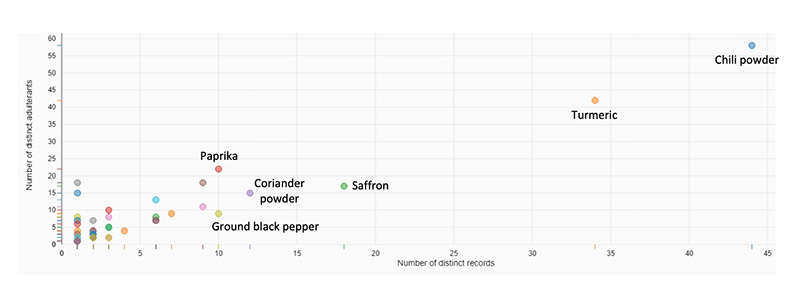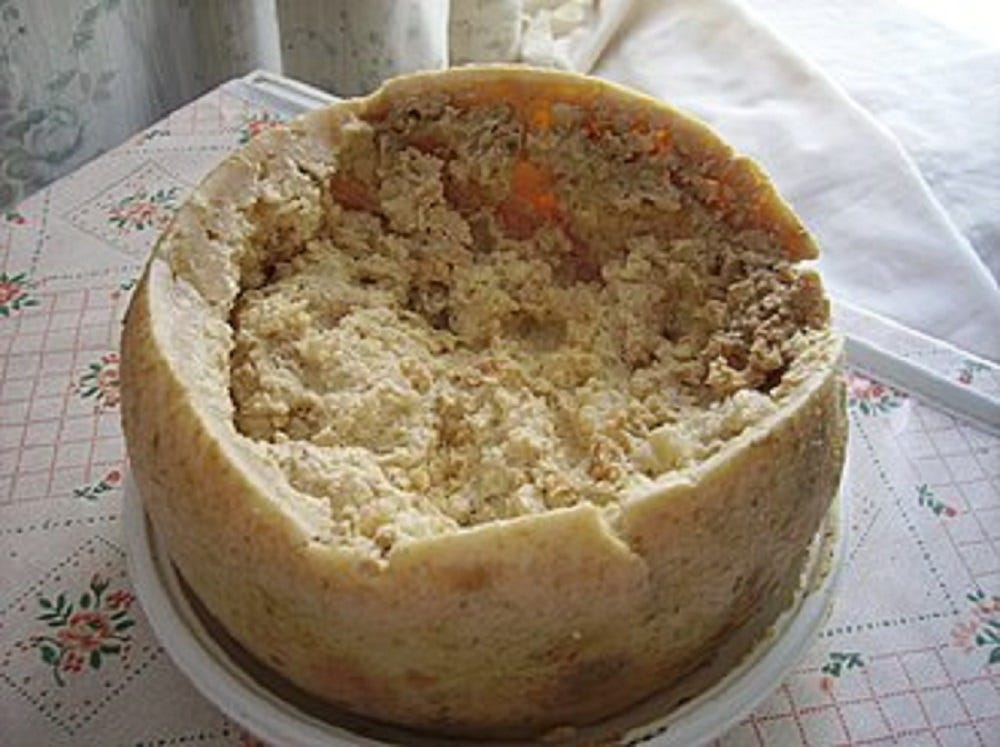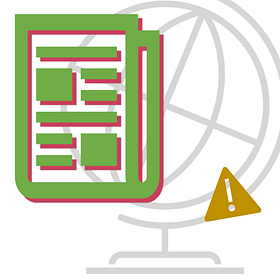138 | Erratum | The World's Most Dangerous Cheese |
Plus, supply chain shakeups for key commodities, heaps of free webinars and truly disturbing foods
This is The Rotten Apple, an inside view of food integrity for professionals, policy-makers and purveyors. Subscribe for weekly insights, latest news and emerging trends in food safety, food authenticity and sustainable supply chains.
Erratum (Paprika fraud);
The world’s most dangerous cheese;
Palm oil, cocoa, coffee and soy supply shakeup;
Food Safety News and Resources;
Truly Disturbing Foods (just for fun);
Food fraud news, emerging issues and recent incidents
Is it erratum or errata? Either way, I got the details of the sample sourcing wrong in last week’s paprika fraud story. I correct those details in this week’s issue, and answer a reader’s question about whether the same thing is happening in spices now.
Welcome to Issue 138. A huge thank you to new subscribers 👏👏 Charles and Anna 👏👏 and to long-time subscriber Victoria who has provided invaluable financial support over the years: it’s people like you who keep this newsletter alive.
Today’s newsletter has infested cheese, supply chain shakeups and lots of webinars in our weekly roundup of food safety news and resources. Plus, don’t miss this week’s meet-up!
Thanks for being here,
Karen
P.S. Our May meetup is on this Thursday. Join us for an informal chat about food safety and food fraud - everyone is welcome.
Paprika Fraud Follow-Up

Last week’s story about paprika fraud was a big hit with readers. I was so pleased to share Tom’s story from his days as an inspector for the New York State (NYS), Department of Agriculture and Markets.
Unfortunately, I got some of the details incorrect. The initial sample of paprika was spotted and purchased by NYS Food Inspector Audrey, not by Tom.
The products in the picture were purchased later by Tom, after lab tests on the initial sample showed that paprika from this brand contained high levels of illegal, carcinogenic Sudan dyes.
Tom has kept them ever since. “Later on,” says Tom, “realizing this product would be thrown away, I went to the store and obtained more. Such a great sample! Thanks again!”
Is this still happening?
Reader and fellow food writer, Larissa Zimberoff of Technically Food, responded to the story with a question: how much spice fraud is found now, compared to when those paprika samples were tested in 2016? Less, or more?
I wish I could give you solid data on this, but fraud, by its very nature, is not accurately measured. My best guess is that spice adulteration is probably happening about as often now as it did then.
Most people are shocked to hear that government agencies almost never test for such frauds. When Tarantelli contacted the Australian consumer group Choice in the aftermath of the paprika-Sudan dye discovery in New York, encouraging them to test spices in Australia they told him they had no budget for such analyses.
Premium spice brands have been aware of adulteration risks for decades and take great care to protect their consumers and brands. In the past few years, large retailers like Costco, Walmart etc. also appear to be paying more attention to food fraud risks in their supply chains.
The largest risks are with smaller brands, unbranded (bulk) materials, independent outlets and food markets. They and their suppliers are likely to have poor visibility - or no visibility - of their supply chains, are unlikely to test products and are therefore more vulnerable to buying and selling adulterated spices.
Unfortunately, such adulteration is still happening, as evidenced by the lead in cinnamon applesauce scandal discovered in the USA last October. The US FDA reported that the lead, and another heavy metal, chromium were not present in the unprocessed cinnamon sticks from Sri Lanka, and lead chromate has a history of use as an unauthorised colourant in spices, including turmeric. This points to fraudulent adulteration as the source of the lead.
As for Sudan dye adulteration of foods, just last month Italian authorities rejected palm oil from Ivory Coast because it contained Sudan 3 and Sudan 4 dyes and German authorities recalled cheddar cheese powder from Syria which contained multiple Sudan dyes.

The World’s Most Dangerous Cheese?
Casu Marzu is “The world’s most dangerous cheese” according to Guinness World Records.
Why dangerous? Oh, just because it’s traditionally eaten while full of live maggots. The maggots allegedly pose a risk of intestinal myiasis, which is an infestation of a person’s intestines with living fly larvae.
The species of maggot found in Casu Marzu cheese, Piophila casei, can survive in acid environments, including the acid found in the stomach of humans for 120 hours. Myiasis can cause abdominal pain, vomiting, and diarrhoea.
Side note: While researching this article I stumbled on a case study of a 1 year old American child who was passing stools containing live maggots. Doctors suspect the cause of the infestation was her diet of overripe bananas, which were stored uncovered, with “flies observed on and around the fruit”. Yeeooch 🤮
Apparently, the cheese, a speciality of the island of Sardinia in Italy, is very tasty. It is said to have a flavour that is “intense with reminders of the Mediterranean pastures and spicy with an aftertaste that stays for hours” (CNN).

How to make Casu Marzu
Take a wheel of traditional hard sheep’s milk cheese from Sardinia such as fiore sardo, a pecorino-like cheese. Leave it where it will be discovered by Cheese skipper flies (Piophila casei), which will lay their eggs in cracks in the cheese.
Wait three months for the fly eggs to hatch into maggots and the maggots to digest the fats and proteins in the cheese into a soft, creamy paste inside the untouched rind.
Crack open the top of the cheese, scoop out the creamy goop containing wriggling maggots*, and eat. Or you may prefer to centrifuge the creamy parts first, a process which “merges” the maggots with the cheese.
*Sardinians believe that the cheese is only safe to eat while the maggots are alive.
How dangerous is it?
The cheese is considered illegal under Italian law due to safety concerns, and cheese sellers face possible fines of €50,000.
However, a Sardinian food researcher, Roberto Flore says he’s not concerned about the safety of the cheese, saying “I believe that nobody has ever died eating casu marzu. If they did, maybe they were drunk. You know, when you eat it, you also drink lots of wine.”
“I believe that nobody has ever died eating casu marzu. If they did, maybe they were drunk. You know, when you eat it, you also drink lots of wine.” - Roberto Flore, food researcher
The author of a food masters thesis on the topic also asserts that the likelihood of the maggots directly causing serious health problems due to myiasis is low. There are no recorded cases of myiasis from the consumption of Casu Marzu.
On the other hand, there are a number of other food safety hazards that could be present, including:
bacterial pathogens if unpasteurised cheese is used as the base;
bacterial and viral pathogens deposited by flies;
histamines and other biogenic amines, present due to the bacterial breakdown of proteins. Histamine levels in Casu Marzu can be high, exceeding limits set for fishery products by a factor of three;
nitrosamines, which are carcinogenic, formed from biogenic amines;
allergen hazards (milk and insects);
prion diseases such as TSE (transmittable spongiform encephalopathies) transmitted by flies.
Perhaps the most alarming hazard is getting hit in the face by a jumping maggot as you bring the cheese to your lips. Maggots can leap a distance of around 15 cm (6 inches) when disturbed.
Sources:
Hay, M. (2020). The secret resistance behind the world’s most dangerous cheese. [online] The Outline. Available at: https://theoutline.com/post/8843/casu-marzu-cheese-sardinia-illegal-dangerous.
Hoffmans, Y. (2018). Master thesis Food Safety Law Unsafe Casu Marzu. [online] Available at: https://edepot.wur.nl/443591.
Petroni, A (2021). Casu marzu: The world’s ‘most dangerous’ cheese. [online] CNN. Available at: https://edition.cnn.com/travel/article/casu-marzu-worlds-most-dangerous-cheese/index.html
Palm oil, cocoa, coffee and soy supply shakeup
Europe’s new deforestation rules, which require businesses that sell soy, beef, palm oil, cocoa, coffee or chocolate into European Union markets to show evidence that they did not contribute to forest degradation or deforestation are due to be enforced from 30 December this year. Commentators report that most commodity traders are not fully prepared for the new rules, are predicting big shakeups in the trade flows for these commodities.
I’ve previously warned of new food fraud vulnerabilities related to the rules, which I suspect will motivate some traders to misrepresent the geographical origin of these commodities when destined for EU markets.
In October’s food fraud news, I also reported that 74% of soy from key growing areas of Brazil are unlikely to meet the new requirements, but not necessarily because of deforestation issues.
The European coffee industry has said the rules will be “shattering” to small coffee growers, who they say are not ready to provide the required information to their buyers.
Cocoa prices could be impacted, particularly in Europe, the world’s largest importer of cocoa beans. Prices are already soaring and the new rules are adding to trader’s fears of worsening shortages in Europe.
Palm oil traders have already begun to divert oil from suspect regions to non-EU markets, with soybean traders predicted to follow suit.
Takeaways for food professionals
If your food business purchases soy, beef, palm oil, cocoa, coffee or chocolate expect changes in their supply chains.
For purchasers in the European Union, there could be delays or disruptions in supply, plus a higher likelihood of fraud related to origin and traceability.
Purchasers in non-EU markets may experience flow-on effects and may receive commodities of lower grades or from different sources than in the past.
Commodities may be transhipped through intermediate countries to obscure origins.
In short: 🍏 EU deforestation rules are disrupting supply chains 🍏 Affected commodities are soy, beef, palm oil, cocoa, coffee or chocolate 🍏 Supply chain disruptions can impact prices and increase food fraud vulnerabilities 🍏
Further reading:
🍏 Cocoa Supply Chain Risks, Issue 114 🍏
🍏 Testing for ‘Deforestation’ in Soybeans, Issue 98 🍏
Food Safety News and Resources
Our news and resources section includes not-boring food safety news plus links to free training sessions, webinars and guidance documents: no ads, no sponsored content, only resources that I believe will be genuinely helpful for you.
This week’s low: bodily fluids in restaurant food for a month?!
Click below for access.
Food Safety News and Resources | May
13 May | Food Safety News and Free Resources | Man charged over ‘bodily fluids’ in food (USA) | Recall: Organic walnuts for STEC E. coli (USA) | Recall: Roasted nuts recalled for possible Listeria contamination (USA) | Large outbreak: 547 sick with
(More) Truly disgusting foods - just for fun
This week’s just-for-fun video features the maggoty cheese Casu Marzu from our main story, plus even more disturbing foods such as shark fins, bird’s nest soup, and perhaps the worst of all, the French delicacy known as Ortolan. Can’t believe anyone ever thought that was a good idea. Enjoy!
Below for paying subscribers: Food fraud news, horizon scanning and incident reports
📌 Food Fraud News 📌
Protein supplements found to be mislabelled and contaminated at alarming levels
A survey of protein supplements found almost 70% of samples contained at least 10% less protein than advertised, with many also containing aflatoxins, pesticides and heavy metals. The survey, conducted by researchers and self-funded, was performed on 36 popular protein-based herbal and dietary supplements





